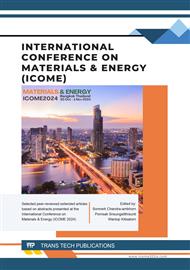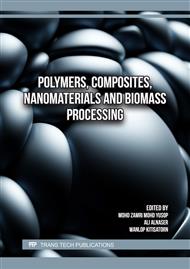[1]
P. Nurthen, O. Bergman, and I. Hauer, Modified powders 'point the way to designer alloys', Met. Powder Rep. 63 (2008) 24-35.
DOI: 10.1016/s0026-0657(08)70106-1
Google Scholar
[2]
K. P. Furlan et al., Influence of alloying elements on the sintering thermodynamics, microstructure and properties of Fe–MoS2 composites, J. Alloys Compd. 652 (2015) 450-458.
DOI: 10.1016/j.jallcom.2015.08.242
Google Scholar
[3]
B. Šuštaršič, L. Kosec, M. Kosec, B. Podgornik, and S. Dolinšek, The influence of MoS2 additions on the densification of water-atomized HSS powders, J. Mater. Process. Technol. 173 (2006) 291-300.
DOI: 10.1016/j.jmatprotec.2005.04.122
Google Scholar
[4]
M. Selecká, A. Salak, and H. Danninger, The effect of boron liquid phase sintering on properties of Ni-, Mo- and Cr-alloyed structural steels, J. Mater. Process. Technol. 141 (2003) 379-384.
DOI: 10.1016/s0924-0136(03)00421-7
Google Scholar
[5]
K. Furlan, J. Assunção, G. Paz, C. Binder, and A. Klein, Sintering Studies and Microstructural Evolution of Fe-MoS2 Mixtures, Mater. Sci. Forum. 802 (2014) 415-420.
DOI: 10.4028/www.scientific.net/msf.802.415
Google Scholar
[6]
B. Šuštaršič, L. Kosec, S. Dolinsek, and B. Podgornik, The characteristics of vacuum sintered M3/2 type HSSs with MoS2 addition, J. Mater. Process. Technol. 143-144 (2003) 98-104.
DOI: 10.1016/s0924-0136(03)00328-5
Google Scholar
[7]
B. Sustarsic, L. Kosec, M. Jenko, and V. Leskovsek, Vacuum sintering of water-atomised HSS powders with MoS2 additions, Vacuum. 61 (2001) 471-477.
DOI: 10.1016/s0042-207x(01)00161-0
Google Scholar
[8]
S. Mahathanabodee, T. Palathai, S. Raadnui, R. Tongsri, and N. Sombatsompop, Dry sliding wear behavior of SS316L composites containing h-BN and MoS2 solid lubricants, Wear. 316(2014) 37-48.
DOI: 10.1016/j.wear.2014.04.015
Google Scholar
[9]
K. P. Furlan, C. Binder, A. N. Klein, and J. D. B. d. Mello, Thermal stability of the MoS2 phase in injection moulded 17-4 PH stainless steel, J. Mater. Res. Technol. 1 (2012) 134-140.
DOI: 10.1016/s2238-7854(12)70024-8
Google Scholar
[10]
M. Peruzzo, F. L. Serafini, M. F. C. Ordoñez, R. M. Souza, and M. C. M. Farias, Reciprocating sliding wear of the sintered 316L stainless steel with boron additions, Wear. 422-423 (2019) 108-118.
DOI: 10.1016/j.wear.2019.01.027
Google Scholar
[11]
V. Songsujaritkul, S. Mahathanabodee, and R. Tongsri, Effect of Sintering Temperature and Cooling Rate on the Microstructure and Hardness of Fe-Cr-Mo-V-W-C Sintered Steel added with MoS2, IOP Conf. Ser. Mater. Sci. Eng. 965 (2020) 012025.
DOI: 10.1088/1757-899x/965/1/012025
Google Scholar
[12]
R.-t. Liu and X. Xiong, Tribological properties of sulfur-containing high-speed steels at elevated temperature, Trans. Nonferrous Met. Soc. China. 23 (2013) 1674-1680.
DOI: 10.1016/s1003-6326(13)62647-3
Google Scholar
[13]
X. Liu et al., Tribological behavior of M50-MoS2 self-lubricating composites from 150 to 450 °C, Mater. Chem. Phys. 198 (2017) 145-153.
DOI: 10.1016/j.matchemphys.2017.05.044
Google Scholar
[14]
H.-d. Wang, B.-s. Xu, J.-j. Liu, and D.-m. Zhuang, Investigation on Friction and Wear Behaviors of FeS Films on L6 Steel Surface, Appl. Surf. Sci. 252 (2005) 1084-1091.
DOI: 10.1016/j.apsusc.2005.02.033
Google Scholar
[15]
R. Tomoshige, K. Niitsu, T. Sekiguchi, K. Oikawa, and K. Ishida, Some tribological properties of SHS-produced chromium sulfide, Int. J. Self-Propagating High-Temp. Synth. 18 (2009) 287-292.
DOI: 10.3103/s1061386209040104
Google Scholar



